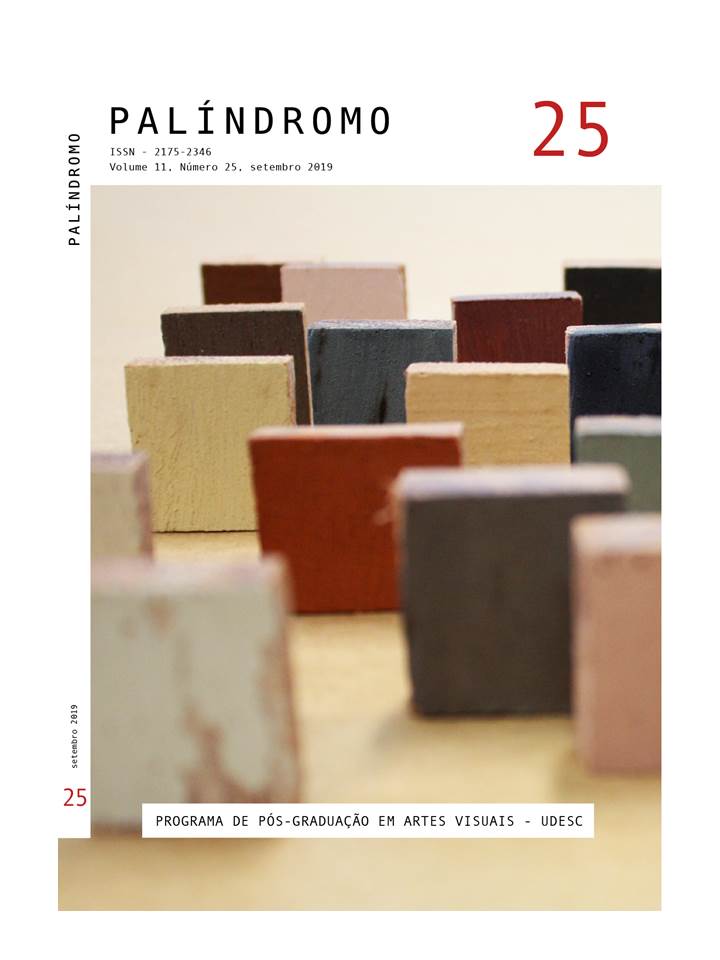EXIST AS ART: WHAT IS IT FOR?
DOI:
https://doi.org/10.5965/2175234611252019191Keywords:
photography, self-referential, memory, poeticsAbstract
This article features a cut-out of the work of visual artist and photographer Walter Karwatzki (Maceió/AL, Brasil, 1959). In it are evidenced three works with the technique of photography that have as platform the body of the artist. The works emphasize the passage of the photographer who used to see only the other, to the photographer who, now, sees and shows himself to the other, a change that happens due to a situation of death through which he passed. The works presented are endowed with a resulting dramaturgy of social aspects, sometimes of cultural aspects or of the artist’s personal aspects. In these works, the body is charged with a great self-referential meaning. This article presents the photographic trajectory of the author in eight photographic works that, in one way or another, have their poetic production in constant approximation with the question of memory, having as references Samain (2012), Achutti (1997, 2004), Didi -Huberman (2010), Dubois (1993), Bossi (2010), Canclini (2013) and Tolstoy (2016), among others.
Downloads
References
ACHUTTI, L. E. R. Fotoetnografia: um estudo de antropologia visual sobre cotidiano, lixo e trabalho. 1. ed. Porto Alegre: Tomo Editorial, 1997.
________. Fotoetnografia da Biblioteca Jardim. 1. ed. Porto Alegre: UFRGS/Tomo Editorial, 2004.
BAUMAN, Z. Identidade. 1. ed.. Tradução de Carlos Alberto Medeiros. Rio de Janeiro: Zahar, 2005.
BLAUTH, L. Pesquisa em arte: Luas Negras resultantes de um processo gráfico. In: BLAUTH, L; SIMIONATO, M. F. (Org.). Educação, estética e cultura: percursos e inves-tigações. 1ª edição. Novo Hamburgo: Feevale, 2008, p. 87 – 95.
BOSSI, A. Plural, mas não caótico. In: BOSSI, A. Cultura brasileira: temas e situações. 4. ed. (Org.). São Paulo: Ática, 2010, p. 7-15.
CAMARGO, D. Poeplano. 1. ed.Porto Alegre: Projeto POA, 2010.
CANCLINI, N. G. Culturas híbridas: estratégias para entrar e sair da modernidade. 4. ed. Tradução de Ana Regina Lessa, Heloísa Pessa Cintrão e Gênese Andrade. São Pau-lo: USP, 2013.
CANONGIA, L. O legado dos anos 60 e 70. 1. ed. Rio de Janeiro: Jorge Zahar, 2005.
CANTON, K. Corpo, identidade e erotismo. 1. ed. São Paulo: WMF Martins Fontes, 2009.
CATTANI, I. B. Mestiçagens na arte contemporânea: conceito e descobramentos. In: CATTANI, I. B. Mestiçagens na arte contemporânea: conceito e desdobramentos. Mestiçagens na arte contemporânea. 1. ed. (Org.) Porto Alegre: UFRGS, 2007, p 21-34.
DIDI-HUBERMAN, G. O que vemos, o que nos olha. 2. ed.. Tradução Paulo Neves. São Paulo: Editora 34, 2010.
DUBOIS. P. O ato fotográfico e outros ensaios. 9. ed. Campinas: Papirus, 1993.
GALEANO, E. O livro dos abraços. 2. ed. Tradução de Eric Nepomuceno. Porto Alegre: L&PM, 2007.
GUATTARI, F.; ROLNIK, S. Micropolítica: cartografia do desejo. 5. ed. Petrópolis: Vo-zes, 1999.
HARAZIM, D. O instante certo. 1. ed. São Paulo: Companhia das Letras, 2016.
MURAD, C. A. Fotografia contemporânea e a Imagem do Olhar Cristal. Disponível em: http://www.fotopoetica.ufrj.br/wp-content/uplo-ads/2016/03/Alice_20-11_01.pdf. Acesso em: 9 de mar. de 2018, p. 4-8.
PAZ, O. Conjunções e disjunções. 1. ed. São Paulo: Perspectiva, 1979.
REY, S. A dimensão crítica dos escritos de artistas na arte contemporânea. 2008. Disponível em: https://www.eba.ufmg.br/revistapos/index.php/pos/article/viewFi--le/2/1. Acesso em 10 de mar. de 2018, p. 8-15.
SAMAIN, E. As peles da fotografia: fenômeno, memória/arquivo, desejo. Disponível em: https://www.revistas.ufg.br/VIS-UAL/article/viewFile/23089/13635?jour--nal-VISUAL. Acesso em: 22 de dez. de 2016. VISUALIDADES, Goiânia v.10/n.1, jan-jun 2012, p. 151 -164.
TOLSTÓI, L. O que é arte: a polêmica visão do autor de Guerra e Paz. 2. ed. Tradução de Bete Torii. Rio de Janeiro: Nova Fronteira, 2016.
Downloads
Published
How to Cite
Issue
Section
License
Copyright (c) 2019 Palíndromo

This work is licensed under a Creative Commons Attribution 4.0 International License.
COPYRIGHT STATEMENT
The articles published by the magazine are free to use, intended for academic and non-commercial applications. Copyright is all assigned to the magazine. The articles whose authors are identified represent the expression from the point of view of their authors and not the official position of Palíndromo Magazine. The author (s) commits to whenever they publish material referring to the article published in Palíndromo mention this publication as follows:
This article was originally published by Palíndromo magazine in its volume (place the volume), number (place the number) in the year of (place the year) and can be accessed at: http://www.revistas.udesc.br/index.php/palindromo


